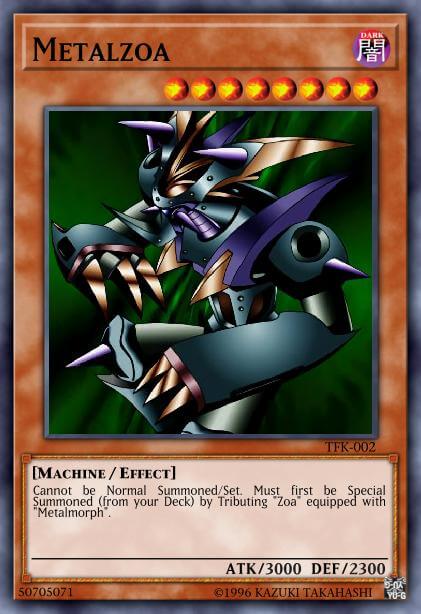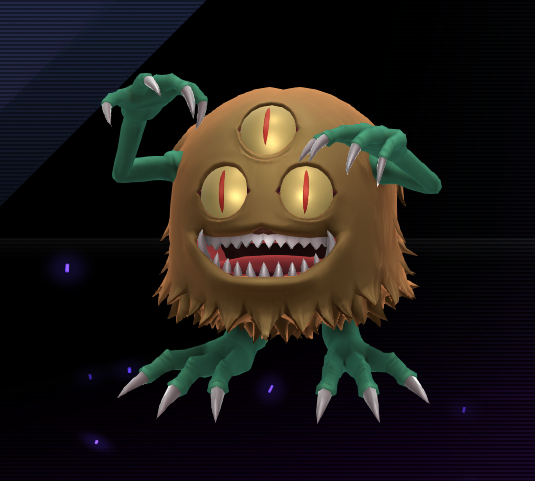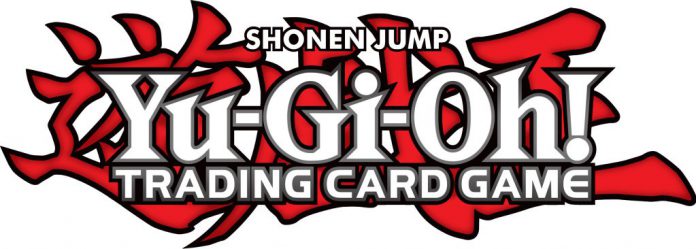Welcome back to another Yu-Gi-Oh! article. Bet you didn’t think you’d see another one huh? Well I’m still absolutely on my bullshit and ready to continue talking about the game.
This is a follow-up article to my previous article you can find here. In that article I mentioned some free-to-play digital versions of everyone’s (EVERYONE’S) favorite Trading Card Game (TCG), Official Card Game (OCG) if you’re in Asian countries. I don’t know why they make that distinction. Maybe they disallow trading cards in those regions. Who knows? I know I’ve traded some valuable cards for trash garbage, because I was an ignorant child and people can easily lie to me. Maybe trading should be outlawed around the world to protect the children and their precious cards. All I know is some jerk traded me Zoa and Rare Metalmorph because he said I could summon Metalzoa. This is not the case. I am eternally mad about this. They were pretty shiny tho.

He looks pretty cool, but as is incredibly obvious by his effect: YOU MUST SUMMON HIM EQUIPPED WITH METALMORPH. This is a SPECIFIC CARD and is DIFFERENT FROM RARE METALMORPH. WHY KONAMI WHY?!
Master Duel

Released on January 18, 2022, Master Duel is the premier online Yu-Gi-Oh! experience The only thing missing is that body odor stench of the opponent opposite you, to your left, your right, and the guy watching your game over your shoulder. Don’t worry the shoulder guy is your friend and totally isn’t judging every play you make. He’s also better than you. You need to stink more.
Master Duel is totally free to play, and has robust single player content currently consisting of 2 tutorials, 19 stories, and one single player challenge mode. In all of these modes, apart from the tutorial, you have the privilege of using a “loaner” deck or a deck that they built. In the stories the player is presented with the basic story of an archetype and a progression of between 4 and 7 duels. Some of these stories are longer than others and may have additional story segments. The segments aren’t anything special, just a slideshow of text with card art, but it’s mildly entertaining to learn the lore behind the cards. Each duel provides rewards ranging from a currency to unlock more duels, and entire decks made from cards in the archetype of the story. I highly recommend playing through some of this content before jumping in to building a deck and paying actual money into the game.
The single-player challenge mode is a series of 10 duels, in all of which you can use a loaner deck or your own custom deck, and the rewards for completion are gems. Extremely straightforward. If you need to buy packs, just run this challenge down. This is definitely something you’ll want to engage in if you are playing the game long-term.
Which brings me to my next point. The only micro-transaction is for the in-game currency which can also be earned through normal gameplay. The conversion of gems is pretty steep as well: $1 per 50 gems and the “free” gems you receive as an incentive don’t add much more value. The largest gem purchase gets you 4,155 purchased gems for the $80 spent and 795 gems for free. This only gets you 11 extra gems per dollar. Thankfully, Konami is kind enough to allow you to purchase actual good deals on gems every so often. If you want to spend money on this game, simply wait for these special deals. You earn enough gems to comfortably make a single deck without purchasing anything. There are a number of things you can spend your gems on. Most of them are cosmetics; different duel fields, little buddies that hang out next to your field while you play, “card sleeves”, and user icons; the other items are packs and the Duel Pass, which is just a fancy way of saying the game has a season pass. The price for cosmetics varies: 100 for card sleeves, 600 for Duel Fields, 300 for the little buddies, and 50 for player icons. The Duel Pass costs a whopping 800 gems. This is an auto-buy as the Duel Pass pays for itself through the progression and rewards you with materials for card crafting and items. Which brings me to the price of packs.
 This is the best buddy in the game hands down. His name is Sangan and he is my son.
This is the best buddy in the game hands down. His name is Sangan and he is my son.
Master Duel is run as the same Hearthstone or Magic: the Gathering: Arena, you can craft cards or pull them in packs. In my opinion, Master Duel makes buying and opening packs a lot easier than the other games. You earn the gems, and you spend the gems on packs. Well now you might be wondering “How many gems does one pack cost?”, well it’s 100 gems you eager beaver. Couldn’t let me get there on my own?
So, if we refer to my quick analysis of gems earlier, 100 gems is roughly two real world dollars. It’s very easy to earn 100 gems. What’s a little harder is earning 1,000 gems, the price of 10 packs. Master Duel only lets you buy packs in quantities of 1 or 10 at a time. It’s honestly not worth buying packs unless you buy 10 at once. Apart from just increasing your odds to pull good cards, buying 10 at a time guarantees you pull at least one SR card. If the set of 10 cards don’t reward you with a UR, you’re next purchase of 10 packs in that set will guarantee a UR.
Once you’re actually ready to buy packs you have some options:
Master Packs: These contain the entirety of the card pool. Possibly the worst packs to buy unless you look at the following options and decide “These suck and I hate them”.
Selection Packs: These packs contain a limited card pool. Konami lets you know explicitly what cards are available when you go to purchase the packs in the “Cards included in this pack” menu option. If you want any of the cards or archetypes included in these packs, then you should buy these with your gems. You’re guaranteed to get the cards included and nothing you don’t.
Secret Packs: These packs are unlocked by crafting certain cards in the “Deck” menu, or by pulling specific cards in other packs (or even Secret Packs themselves!). When you unlock a Secret Pack they are available to you for 24 hours, and when you unlock a Secret pack by crafting a card you receive a one-time, free copy of the pack you just unlocked. This is a mystery mouseketool that we will talk about later. What sets Secret Packs apart is that when you pull cards from these packs there is a card pool from which you are guaranteed to draw 4 out of your 8 cards. The other 8 cards will be from the card pool available in the Master Packs.
One thing to note is that unlike M:tG:Arena the packs in Master Duel don’t have duplicate protection. You’ll have to manually go into the deck editor and use the “Dismantle All Extras” tool in the options menu to automatically dismantle any copies of cards that you have in excess of 3 copies. In addition, if you pull cards of different foilings they do not count towards the 3 copies of other foilings, so if you want to dismantle cards of different foilings you’ll have to do that manually.
The other way to obtain cards is to craft them using bespoke materials in the Deck Editor menu. You gain materials either from dismantling cards you don’t like or from the Duel Pass. Every card costs 30 of the material required. Now here’s the catch, materials are broken into four categories: N, R, SR, and UR. Each type of material can be used to craft cards of the corresponding rarity (N, R, SR, UR). Lower grade materials cannot be converted into higher grade materials, and the materials cannot be purchased for gems. Every time you craft a card, and also whenever you open packs, you have a chance of the card crafting as one of the foils: non-foil, holo foil, and royal finish. This is important if you like fancy looking cards, OR if you really need certain crafting materials. Each foiling deconstructs into a different amount of the crafting material corresponding to the card’s rarity. Non-foils dismantle into 10 materials, holo foils dismantle into 15 materials, and royal finishes dismantle into 30 materials (WOW THAT’S THE FULL COST OF CRAFTING A CARD, this will be important for the mystery mouseketool later).
Let’s talk about the ranked mode and the meta. It is VERY different from the paper card game meta. For starters, there is only one ranked ladder and the games are only played as a best-of-one. This means that strategies that try to deal massive burn damage in a single turn, or take the second turn to try and deal massive combat damage. Players have been begging for a best-of-three ladder since the game was released. Konami has sent out several surveys asking for the opinions of the player base and they’ve actually implemented some of the suggested changes. So, hopes are high in the community
Another difference is that Master Duel has a different banlist from both the TCG and OCG meta games and is several set releases behind the TCG (which is naturally several releases behind the OCG). This makes sense as the game is balanced around being a best-of-one rather than a best-of-three and has a much earlier card pool. The best-of-one system isn’t very different from other digital card games, but Yu-Gi-Oh! players are so accustomed to best-of-three and the usage of a side deck that the addition of this mode to Master Duel will be a huge boon to the longevity of the game.
Since this is a Getting Started article I’m going to let you in on a little secret: There’s a really cool exploit that allows you to open a bunch of secret packs for free. Remember how I mentioned that when you craft cards you can unlock Secret packs and you get a free pack? Yeah well some cards craft TWO SECRET PACKS AT ONCE! So of course there’s a strategy based around this fact to maximize the Crafting Material-to-Free Pack ratio. I’m going to take the liberty of supplying you with this list below:
SR’s (require 300 SR materials to craft all cards for the free packs):
All of the cards listed below give you 2 free packs with the exception of Marshalling Field, which gives you 3 packs.
- Marshalling Field
- Ancient Gear Gadjiltron Dragon
- Charging Gaia the Fierce Knight
- Elemental Hero Shadow Mist
- Into the Void
- Phantom Knights’ Rank-Up-Magic Force
- Destined Rivals
- Rune-Eyes Pendulum Dragon
- T.G. Halberd Cannon
- Artemis, the Magistus Moon Maiden
The reason you might want to engage in this clear gamble is that on average you will have spent about 10 SR net materials per card crafted (note that it takes 30 materials to craft the cards) and gain about 4 UR materials (a much more valuable material as a lot of the strongest cards in the game are locked behind the UR rarity). If you have the good fortune to craft and pull foil copies of the SR cards your net materials spent will only decrease further.
Duel Links

I have very little experience with Duel Links, but I feel obligated to include it in this article. I did some research and I’ll try my best to give you a primer.
Duel Links was released on January 11, 2017 for iOS and Android. It was released for Windows 10 months later.
The biggest differences between Duel Link and the TCG is that the field is only has 3 Monster Zones and 3 Spell/Trap Zones and only recently added the two Extra Monster Zones, players start at 4,000 life points instead of 8,000, and the game has CHARACTERS WITH ACTIVATED ABILITIES THAT AFFECT THE GAME STATE AS A CORE MECHANIC. This is pretty much all I know about the game. The only advice I can give is that you should definitely stick with playing as many free cards as possible in order to save your gems. Duel Links is a lot stingier with its gems than Master Duel. So, save your gems until you decide what deck you actually want to build. Maybe net deck it to be safe. If you don’t care about spending money then go wild.
That’s it for the official digital formats for Yu-Gi-Oh!. If i had to recommend playing one of these it would have to be Master Duel. It gives you the best representation of how the game actually plays in paper and is much easier to accrue gems and build decks.
Have any questions or feedback? Drop us a note in the comments below or email us at contact@goonhammer.com.


